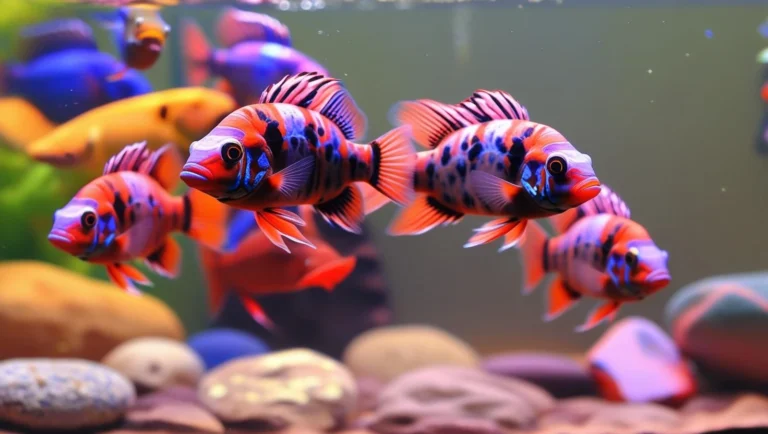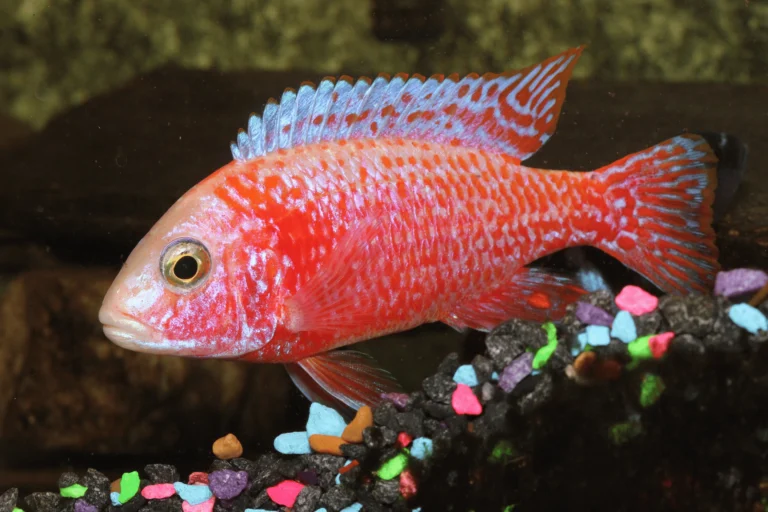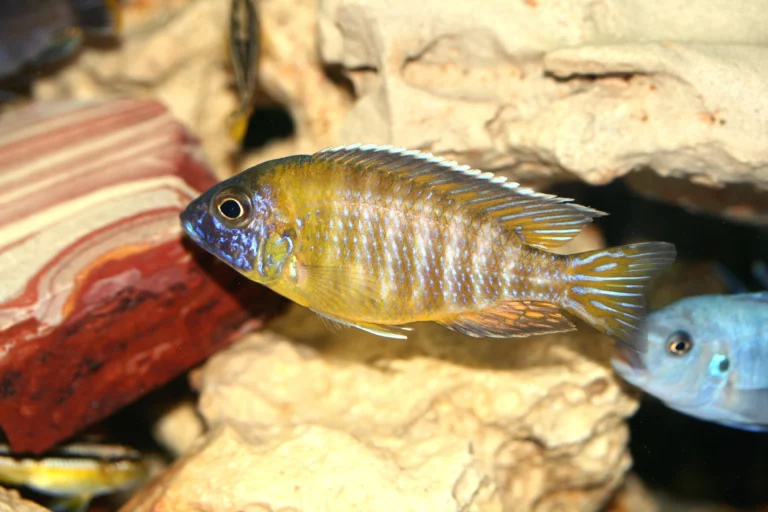Your trusted guide to cichlid care, tank setups, and quality products.

Peacock Cichlid Compatibility: 5 Proven Tips for Success
Discover the perfect tank mates for your peacock cichlids! Our comprehensive guide explores compatibility with other African cichlid species, providing insights into temperament, size, and territorial requirements. Ensure a harmonious and thriving community in your aquarium.
Image credit Canva
Peacock cichlids are one of the most captivating freshwater fish for aquarium enthusiasts, prized for their vibrant colors and generally calm demeanor. While they are less aggressive compared to many other African cichlids, ensuring peacock cichlid compatibility in a community tank still requires careful planning. From selecting the right tank mates to designing an ideal tank environment, every decision you make plays a crucial role in achieving harmony.
In this comprehensive guide, we’ll dive deep into five proven tips for ensuring peacock cichlid compatibility, helping you create a thriving and visually stunning aquarium.
At PeacockCichlid.com, we believe in transparency and honesty with our readers. Some of the links in this article are affiliate links, which means we may earn a small commission if you make a purchase through them—at no additional cost to you. These commissions help support our site, allowing us to continue providing expert advice, in-depth guides, and valuable content for Peacock Cichlid enthusiasts like you.
We only recommend products that we trust and believe will be beneficial for your aquarium. Thank you for your support!
Understanding Peacock Cichlid Compatibility and Temperament
Peacock cichlids (Aulonocara species) hail from the clear, rocky waters of Lake Malawi in Africa. These fish are known for their striking appearance, with males displaying dazzling colors that range from blues and yellows to reds and purples. Females are less colorful but play a significant role in maintaining balance in the tank.
While generally peaceful, male peacock cichlids can be territorial, especially when it comes to breeding. They often establish dominance through displays of aggression toward other males or fish that encroach on their territory. Factors such as overcrowding, insufficient hiding spots, or unbalanced male-to-female ratios can exacerbate aggression.
Understanding these tendencies is the first step in successfully managing peacock cichlid compatibility. Their behavior can be predictable if their environmental needs are met, which minimizes conflicts in a mixed-species setup.
1. Selecting Tank Mates to Improve Peacock Cichlid Compatibility
Choosing the right tank mates is crucial for maintaining peace in a mixed cichlid tank. Peacock cichlids thrive with species that share similar water parameters, temperaments, and activity levels. Here’s a closer look at suitable companions:
Haps (Haplochromis)
Haps are an excellent choice for tank mates, as they share the same origin and environmental requirements as peacock cichlids. Their active nature complements the relatively calm behavior of peacocks, creating a dynamic yet balanced aquarium. Ensure the tank is spacious enough to accommodate their swimming habits.
Mbuna Cichlids
While Mbuna cichlids are generally more aggressive than peacock cichlids, they can coexist if the tank is properly set up. Providing numerous rocks and caves allows each fish to establish its own territory, reducing territorial disputes. Additionally, avoid overly aggressive Mbuna varieties to maintain balance.
Yellow Labs (Labidochromis caeruleus)
Known for their gentle temperament, Yellow Labs are among the most peaceful African cichlids. Their vibrant yellow coloration creates a striking contrast against the rich hues of peacock cichlids, making them a popular pairing for aquarists aiming for visual appeal and harmony.
Synodontis Catfish
Though not cichlids, Synodontis catfish are excellent additions to peacock cichlid tanks. Their peaceful bottom-dwelling nature and ability to clean up leftover food contribute to the overall health of the tank.
2. Cichlid Species to Avoid for Better Peacock Cichlid Compatibility
Not all cichlids are suitable for sharing a tank with peacock cichlids. Choosing the wrong species can lead to stress, injuries, and even fatalities.
Highly Aggressive Cichlids
Aggressive species like Flowerhorns, Midas cichlids, and Red Devils are known for their dominant behavior and territorial nature. These fish often bully more peaceful species like peacock cichlids, creating an unsafe environment.
Cichlids from Different Regions
Cichlids from other regions, such as South American species like Oscars or Discus, often have different water parameter requirements. Peacock cichlids thrive in hard, alkaline water, while South American species prefer soft, acidic conditions. This mismatch can lead to health problems for both groups.
Predatory Cichlids
Large predatory cichlids that view smaller fish as prey should also be avoided. Even if they don’t immediately attack peacock cichlids, their presence can cause stress, leading to compromised health.
3. Optimizing Tank Setup for Peacock Cichlid Compatibility
The size and setup of your aquarium play a significant role in ensuring peacock cichlid compatibility. A spacious, well-decorated tank reduces aggression and allows each fish to establish its own territory.
Tank Size
A minimum tank size of 75 gallons is recommended for a mixed peacock cichlid setup. Larger tanks provide more space for swimming and territorial boundaries, which is crucial for maintaining harmony.
Decor and Hiding Spots
Decorate the tank with plenty of rocks, caves, and artificial plants to create hiding spots and break up sightlines. This helps minimize conflicts by giving fish a place to retreat when they feel threatened. It also mimics their natural habitat in Lake Malawi, reducing stress and promoting natural behavior.
Water Parameters
Peacock cichlids require stable water conditions to thrive. Maintain a pH between 7.8 and 8.6, a hardness level of 8–12 dGH, and a temperature between 75°F and 82°F. Regular water changes and proper filtration are essential to keeping these parameters stable.
4. Proven Tips for Introducing New Tank Mates to Peacock Cichlids
Introducing new fish to an established tank can be challenging. Follow these guidelines to improve peacock cichlid compatibility during the integration process:
- Quarantine New Fish: Always quarantine new additions for at least two weeks to prevent the introduction of diseases or parasites.
- Rearrange the Tank: Before adding new fish, rearrange the decor to disrupt established territories. This helps reduce aggression by resetting territorial boundaries.
- Add in Groups: Introducing multiple fish at once can distribute attention and aggression, making it easier for newcomers to integrate.
- Monitor Closely: Observe the tank closely for the first few days after adding new fish. Look for signs of aggression, such as chasing or fin nipping, and intervene if necessary.
5. Feeding Strategies to Maintain Peacock Cichlid Compatibility
Diet plays a significant role in maintaining peacock cichlid compatibility. Competition during feeding times can lead to aggression, so it’s essential to develop a feeding strategy that meets the needs of all tank inhabitants.
Diverse Diet
Peacock cichlids thrive on a protein-rich diet, while some other cichlids, such as Mbuna, require more plant-based foods. Offer a variety of high-quality pellets, frozen foods, and fresh vegetables to ensure balanced nutrition.
Feeding Techniques
Use multiple feeding spots or sinking foods to minimize competition. Feeding at different levels of the tank allows each species to access food without crowding.
Conclusion
Achieving peacock cichlid compatibility is not a one-time effort—it requires careful planning, ongoing observation, and regular maintenance. By choosing the right tank mates, optimizing the tank setup, and following a balanced feeding regimen, you can create a harmonious and thriving aquatic community.
With these five proven tips, you’ll enjoy a beautiful, peaceful aquarium that highlights the stunning colors and unique behavior of your peacock cichlids.
Enhance your aquarium experience by exploring more of our expert guides at peacochcichlid.com. If you’re looking to create a harmonious community tank, be sure to check out our “7 Best Tank Mates for Peacock Cichlids: A Guide to Harmony” for tips on selecting compatible companions. For more insights into successful breeding and care, our “Breeding Peacock Cichlids: 5 Proven Tips for Massive Success” and “10 Proven Tips to Master Peacock Cichlid Diet and Breeding” articles offer in-depth advice to help you achieve the best results. And if you’re new to the world of peacock cichlids, don’t miss “Peacock Cichlid Care: 7 Powerful Tips for Beginners” to get started on the right foot.
We’re always updating our content with the latest tips and expert advice, so be sure to visit us again and follow our social media channels for more updates and community news. Happy fish keeping!
FAQ’s
What is the best tank size for maintaining peacock cichlid compatibility?
A tank size of at least 75 gallons is ideal for maintaining peacock cichlid compatibility. Larger tanks provide enough space for peacock cichlids to establish territories and coexist peacefully with other cichlids.
Can peacock cichlids live with other cichlids?
Yes, peacock cichlids can live with other cichlids, such as Haps and Yellow Labs, provided they share similar water parameters and temperaments. Avoid aggressive cichlids that may intimidate peacock cichlids.
What makes peacock cichlid compatibility challenging in a community tank?
Peacock cichlid compatibility can be challenging due to their territorial nature, especially among males. Proper tank setup, balanced male-to-female ratios, and compatible tank mates are essential to minimize aggression.
Which cichlid species should I avoid to ensure peacock cichlid compatibility?
Avoid aggressive species like Flowerhorns and Red Devils, as well as predatory cichlids, which can stress or harm peacock cichlids. Cichlids with different water parameter requirements, like South American cichlids, should also be avoided.
What tank mates are most compatible with peacock cichlids?
Suitable tank mates for peacock cichlids include Haps, Yellow Labs, and Synodontis catfish. These species share similar water conditions and temperaments, promoting compatibility.
How can I reduce aggression and improve peacock cichlid compatibility?
To reduce aggression, provide a spacious tank with plenty of hiding spots, maintain stable water parameters, and avoid overcrowding. Rearranging tank decor before adding new fish can also help reset territorial boundaries.
Are Mbuna cichlids compatible with peacock cichlids?
Mbuna cichlids can coexist with peacock cichlids if the tank is large enough and has ample hiding spots. However, avoid overly aggressive Mbuna varieties to maintain compatibility.
Can peacock cichlids live with non-cichlid species?
Yes, peacock cichlids can live with non-cichlid species like Synodontis catfish. These bottom-dwelling fish are peaceful and help maintain tank cleanliness without threatening peacock cichlids.
What role does diet play in peacock cichlid compatibility?
Diet plays a critical role in peacock cichlid compatibility. A well-balanced diet reduces competition during feeding times and ensures all tank inhabitants get proper nutrition. Offering food at multiple spots in the tank can minimize aggression.
How can I introduce new fish without affecting peacock cichlid compatibility?
To introduce new fish, quarantine them first, rearrange the tank decor to disrupt established territories, and add new fish in groups. These steps help reduce aggression and maintain compatibility between peacock cichlids and other cichlids.



